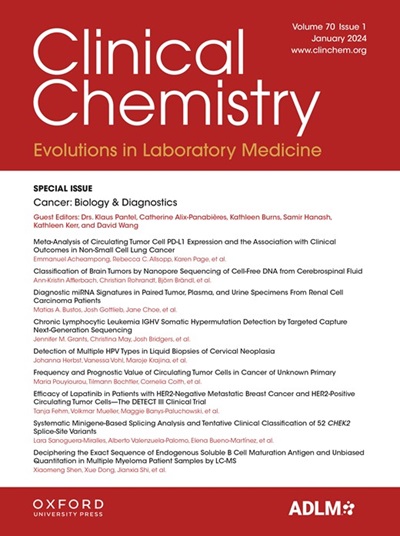B-010 Intercomparison Study of Methods between Atellica Solution® and CI® Analyzers for Sodium, Potassium, and Chloride
IF 7.1
2区 医学
Q1 MEDICAL LABORATORY TECHNOLOGY
引用次数: 0
Abstract
Background Method verification is an essential analysis routinely conducted in accredited Clinical Laboratories whenever a change of method or instrument for a specific analyte is desired. Objectives The aim of the study is to verify that the results measured by the Atellica Solution® analyzer (Siemens) and the new CI® analyzer (Siemens) for Sodium, Potassium, and Chloride are interchangeable. Methods To conduct the intercomparison study of Sodium, Potassium, and Chloride, the techniques were properly calibrated and controlled on both analyzers. For each assay, 40 patient samples were selected, covering the entire measurement range, and analyzed by both instruments. To determine the degree of agreement between the instruments, a Bland Altman analysis of mean differences and a Passing Bablok regression were performed. Statistics are expressed with their 95% confidence intervals (CI). The evaluation of results was carried out using the statistical program Method Validator. Results In both the Bland-Altman and Passing Bablok regression analyses, a slight constant systematic error was detected for all three assays, as the 95% confidence interval of the observed mean difference and the 95% confidence interval of the intercept of the regression line do not include zero. No systematic proportional differences were observed based on the slope, as the 95% confidence interval includes the value one Conclusions The small constant systematic differences found in the analyses should be re-evaluated after performing a new calibration of the methods. In none of the cases are the differences clinically significant, as they do not exceed the total error established in our quality specification. Therefore, it can be concluded that the Atellica Solution® and CI 1900® analyzers are interchangeable for Sodium, Potassium, and Chloride assaysB-010 Atellica Solution® 和 CI® 分析仪之间钠、钾和氯化物分析方法的相互比较研究
背景 每当需要对特定分析物更换方法或仪器时,方法验证是经认可的临床实验室例行进行的一项重要分析。研究目的 验证 Atellica Solution® 分析仪(西门子)和新型 CI® 分析仪(西门子)测量钠、钾和氯化物的结果是否可以互换。方法 为了进行钠、钾和氯化物的相互比较研究,对两台分析仪的技术进行了适当的校准和控制。每种检测方法都选择了 40 份病人样本,涵盖了整个测量范围,并由两种仪器进行分析。为了确定仪器之间的一致程度,对平均差进行了布兰德-阿尔特曼分析,并进行了帕森-巴布洛克回归分析。统计数据以 95% 的置信区间 (CI) 表示。结果评估使用统计程序 Method Validator 进行。结果 在 Bland-Altman 和 Passing Bablok 回归分析中,由于观察到的平均差的 95% 置信区间和回归线截距的 95% 置信区间不包括零,因此所有三种检测方法都检测到了轻微的恒定系统误差。结论 分析中发现的微小恒定系统性差异应在对方法进行新的校准后重新评估。这些差异都没有临床意义,因为它们都没有超过我们的质量规范中规定的总误差。因此,可以得出结论,Atellica Solution® 和 CI 1900® 分析仪在钠、钾和氯化物检测方面是可以互换的。
本文章由计算机程序翻译,如有差异,请以英文原文为准。
求助全文
约1分钟内获得全文
求助全文
来源期刊

Clinical chemistry
医学-医学实验技术
CiteScore
11.30
自引率
4.30%
发文量
212
审稿时长
1.7 months
期刊介绍:
Clinical Chemistry is a peer-reviewed scientific journal that is the premier publication for the science and practice of clinical laboratory medicine. It was established in 1955 and is associated with the Association for Diagnostics & Laboratory Medicine (ADLM).
The journal focuses on laboratory diagnosis and management of patients, and has expanded to include other clinical laboratory disciplines such as genomics, hematology, microbiology, and toxicology. It also publishes articles relevant to clinical specialties including cardiology, endocrinology, gastroenterology, genetics, immunology, infectious diseases, maternal-fetal medicine, neurology, nutrition, oncology, and pediatrics.
In addition to original research, editorials, and reviews, Clinical Chemistry features recurring sections such as clinical case studies, perspectives, podcasts, and Q&A articles. It has the highest impact factor among journals of clinical chemistry, laboratory medicine, pathology, analytical chemistry, transfusion medicine, and clinical microbiology.
The journal is indexed in databases such as MEDLINE and Web of Science.
 求助内容:
求助内容: 应助结果提醒方式:
应助结果提醒方式:


